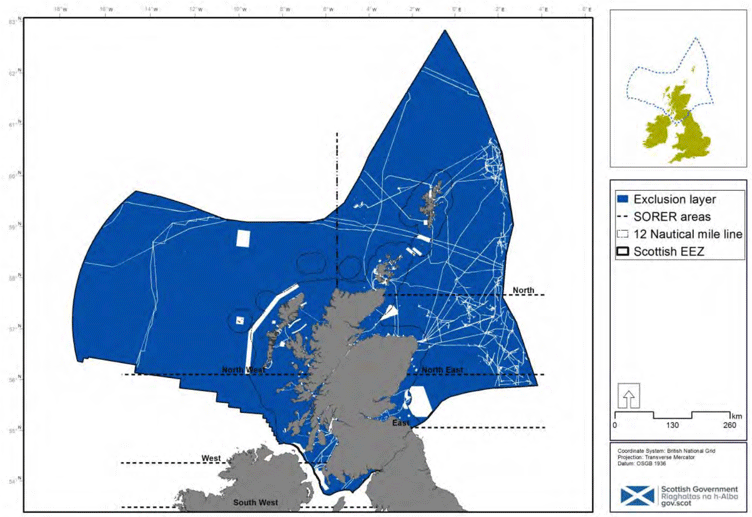Search areas for offshore wind energy: scoping study
Scoping study about identifying areas of search to potentially be developed into draft plan options for offshore wind energy in Scottish waters.
2. Models generated for the scoping study 2018
This study was undertaken to identify the areas of opportunity and constraint based on a number of spatial information layers that have been shown to be important in previous studies. Two models were created to do this. Combining these two models provides a visualisation of where cumulative obstacles to new developments exist. Technical aspects such as resource availability and bathymetry were included directly into the constraint model. The exclusion model was created separately and then used to remove features incompatible with offshore wind development.
The models were presented using the Scottish renewable EEZ as the output extent.
2.1 Exclusion Model
A number of offshore activities and features are not compatible with offshore wind developments. The spatial footprint of these activities has been removed from the spatial calculations to avoid taking forward locations that should not be selected for development.
These activities and structures are not included in the outputs other than as a gap in the resulting output surface. The features considered incompatible are listed below.
- Existing offshore energy leases: Crown Estate Scotland is the authority that grants lease agreements for developments in Scottish waters. It is not possible to plan for developments within existing lease sites hence these have been removed from the calculations
- Hydrocarbon activity and infrastructure: The east coast of Scotland hosts the bulk of the oil and gas installations in Scottish waters. There are a number close to the shore although the majority are concentrated west of the eastern EEZ limit far offshore. It is not recommended that offshore wind developments are developed within oil and gas industry zones
- Aquaculture: Aquaculture is a highly important industry in Scotland in terms of employment and revenue. Currently the Scottish government has plans to expand both the finfish and shellfish production by 50% and 100% respectively. locations leased to aquaculture farming are considered incompatible with offshore wind developments, unless offshore wind is used as a power source for the aquaculture sites themselves
- IMO Routeing (excluding Areas to be Avoided ( ATBAs)), offshore shipping traffic control zones
- Offshore dumping zones either closed or open
- Mapped ship anchorages, mostly found in bays, firths, voes and embayments
This model is based upon that used in the offshore wind scoping study of 2011, Davies and Watret (2011), with the application of a number of updates:
- A number of offshore energy leases sites have changed
- A number of the wind leases in the west have been discontinued and additional wind leases have been granted in the east and north coasts
- Cables and pipelines have been updated using the KIS-ORCA data set
- Hydrocarbon facilities have been updated using data from the UK Oil and Gas authority
- Disposal sites have also been updated with information provided by the Centre for Fisheries and Aquatic Science
These changes have been incorporated into the exclusion layer to ensure it is up to date. The outline of the Scottish coastline is also removed to ensure the multi-criteria calculations do not get applied to land.
Figure 4 shows the exclusion model.
Figure 4: Exclusion model as generated using combined spatial layers that are considered incompatible with offshore wind developments. © Crown copyright and database rights (2018) OS (100024655).

2.2 Constraint model
In order to visualise where broad areas appropriate for development are located, the constraint model is produced by overlaying GIS layers. The layers included are those considered relevant to the selection process for sites of low impact on environmental, socio-cultural or industrial factors that could indicate minimised consenting and licensing risk.
Data layers to be included were collected and standardised in extent, resolution and geographic coordinate system. The inclusion criteria for the constraint model were broad scale relevance to the siting of offshore wind farms. Data layers considered directly relevant to the consenting process and the construction and operation of any potential developments were included in the analysis.
Contact
There is a problem
Thanks for your feedback